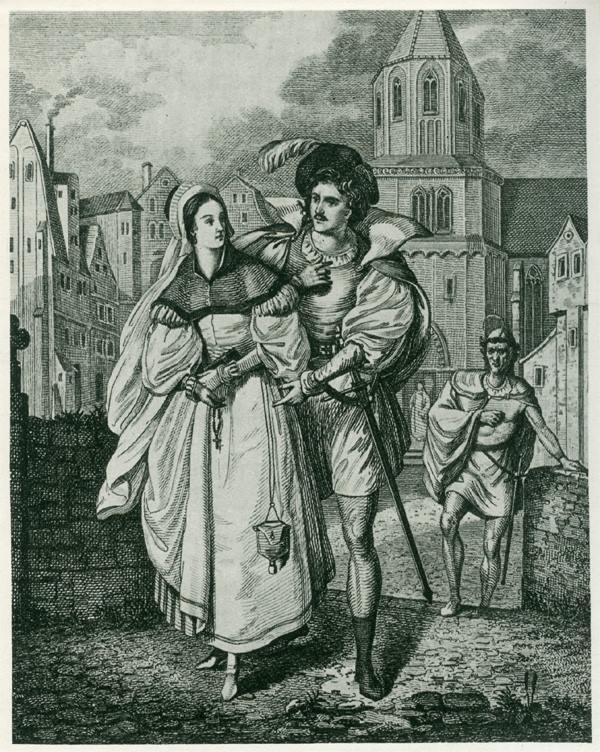I wish to analyze the general mechanics of pacts by focusing on one of the most well-known works of literature, the story of Faust (written in the 1800s, based on previous Germanic folklore), before retreating back to the 1300-1400s, and then looking further back to see what historical basis, if any, we can find for pacts in antiquity.
This lecture shall focus on Johann Wolfgang von Goethe’s Faust, a tragic play in written in the early 1800s in two parts. In the English-speaking world, Faust usually refers to just the first Part of Goethe’s Faust, to a 1500s predecessor by the title of Doctor Faustus by Christopher Marlowe, or to the general myth, which originated in England.
The basic premise of the story is that a man, Dr. Faust, aims to learn all human knowledge possible. The last person in history known to have achieved such a feat is generally regarded to be John Stuart Mill, who was born right around when Goethe wrote the first drafts of Faust Part One, making the background and the character somewhat plausible. God favours Faust, and so Mephistopheles (who is a devil-like entity from German folklore) makes a bet that he can corrupt him. Mephistopheles visits Faust in the form of a poodle (perhaps it was Glasya-Labolas?) and subdues him, gaining access to his home.
 Glasya-Labolas
Glasya-Labolas
From there, they form a pact: Mephistopheles will perform great feats for Faust, but Faust must serve him in Hell. If at any moment Faust feels pleased so much that he wants to have that moment for life, he will immediately die. They do interesting things like go to a bar and get everyone drunk and turn them into monkeys. Eventually, Faust implores Mephistopheles to aid him in seducing Gretchen, the object of his desires. In this turn of events, Gretchen accidentally kills her own mother in order to sneak off to sleep with Faust, and becomes pregnant. Upon drowning their bastard child, she is put in jail. Eventually, in Goethe’s version, god redeems her (one theory being that Faust’s resistance vindicated or purified her).

Faust and Gretchen, by Gustav Hohneck
The mechanics of this pact seem interest both in their apparent satire, Goethe being a scientist of acerbic wit thrown into the mix. The dynamics firmly place humanity above both internality as well as divinity: namely, because Faust wins. The basic formula of behind the operations of Faust (and Goethe) is “All things are nothing to me.” This lack of concern empowers Faust to bend a contract rather than become beholden to it. I think that if one learns anything from Faust, let this be it.
This depiction of Faust is rather light-hearted compared to previous literature. Equally fictitious, this strain emerged in the early 900s, in texts such as the Canon Episcopi, where indigenous European folkloric practices were re-explained in terms of Catholic doctrine. This was largely to deflate rumours that witches could do crazy things like fly around — people generally started to believe this and this apparent magical activity threatened the homogeny of the Church, which has enjoyed a monopoly on morality and miracles for some time. The Canon Episcopi were not influential until later on, in the late 1300s and by the 1450s. By this time, scholars had basically codified what Catholic authorities believed was a real and thriving witch cult that haunted Europe — and mobilized to purify the religious practices of peasants. it is not that these peasants did not accept Jesus or god. It was that they practiced things the Catholic church wanted to snuff out — such as the reliance upon medicine women instead of going to a male priest and asking for prayer to intervene in problems.
In many places, especially in the Celtic areas, certain people would merely adopt Jesus and god into their existing pantheon rather than go fully monotheistic. Then came several books that claimed that women could use special salves or ointments to literally or figuratively fly to meet the Devil, represented by a goat. The choice here seems to be between whether local gods had horns, or if the choice of a goat was to imply the women committed beastiality. These books originally contained the actual ingredients of these salves, but later the ingredients were changed to the generic and rather predictable “baby’s blood” and such. These books represent a transition from basically calling indigenous (pagan) religious practices for being out of line with Catholicism (as in, people worked with the Catholic trilogy but also clung on to practices involving local fertility goddesses, all of which throughout Europe were in turn referred to as “Diana” by Church authority), to flat out claiming that people made contracts with the devil.
Most of the contracts at this time were imagined first by authorities, then forced out of people as confessions after the fact. The confounding matter is that in many cases, remnants of indigenous religions had fragments of solar worship and astrolatry — you can hardly throw a rock anywhere in the world and not find someone who didn’t have an ancestor who believed the sun was a giant penis, or that Venus was a source of beautiful light (lucibelle). Many of you can imagine the utter shock Catholic missionaries ran into in Scotland and Ireland, where pictures of a guy with horns and a massive cock (Cernunnos) and a woman holding open wide a vagina (Sheela na gig) were on practically every castle and corner.
Nider’s Formicarius (1438) is an interesting nexus, as it specifically mentions Venus (who in the next lecture we will examine as an aspect of Lucifer — “the morning star” being a name for Venus, the stellar object). But were any of these practices actually Satanism or involved Lucifer? No. Is it a really tragic coincidence? Possibly? Is it sheer malice and definitely misogyny? …
The idea of a contract — or “compact” — with demonic entities has no origin in the bible, unless you are willing to read the notion of the covenant of YHVH with the Israelites a certain way. But this is not actually where it came from. It did not come from European folklore either. One source are the Chaldeans and Neo-Platonists — this puts the compact/contract as a device coming from the East after Christianity took hold. These are mentioned in the Confession of St. Cyprian. But I do not think there is a nexus between this and the vast majority of those who were accused of, tried for, and executed on charges of witchcraft (most of these, as I have implied, seemed to be mostly Christian, and the victims of a societal culling on heterodoxy and heteropraxy).

So where did the notion of a pact get injected into Western thought?
Surprisingly, Aquinas believed that demons could only act under the permission of god (the classical view of the Ars Goetia is that one asks god to allow demons to serve the operator). He doubted that people could make explicit pacts (at this time, they were introduced as “compacts” and discussed as theological curiosities) — but he did believe people could implicitly work with the Devil. I feel that he is largely to blame for making the notion of people working with the devil a part of Catholic doctrine. But by the late 1400s, when these accusations became a real phenomenon, they were largely led at the local level, by small-level leaders, probably wishing to keep women in check for having too much influence or power.
